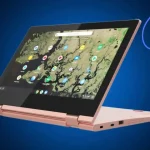Chromebook users who have struggled with customizing their mouse buttons can now rejoice as Google has introduced a new setting that allows users to easily customize their mouse buttons on Chrome OS. This feature is available on the beta channel of Chrome OS in 2020 and requires no additional software to work. Users can now take control of their peripherals and set up their mouse buttons to perform specific functions that suit their needs.
To customize the mouse buttons, users can go to their Chromebook settings and navigate to the connected devices section. From there, they can select the mouse they want to customize and enable the “customize mouse buttons” flag. Once enabled, users can simply click on the buttons they want to customize and assign specific functions to them. This new setting is especially useful for users who have Logitech mice, as the Logitech software for Chromebooks only allows users to pair their devices and does not provide full control over button customization.
Compatibility of Chromebook with Peripherals
Chromebooks have the capability to work with a wide range of peripherals, including both wired and wireless mice. However, a new setting has been introduced in the beta channel of Chrome OS in 2020 that allows users to customize the buttons on their mouse without requiring additional software. This feature provides users with greater control over their peripherals, as they can now set what they want the buttons to do.
To access this feature, users must open their settings and navigate to the “Mouse” section under “Connected Devices.” If the flag “Enable Peripheral Customization” is turned on, users can click “Customize Mouse Buttons” to begin mapping their mouse buttons. Users can click on the buttons they want to customize, and the actions they want to assign to those buttons will appear.
For example, users can assign the middle button to the “Overview” feature, which provides a quick view of all open windows and applications. Users can also assign buttons to features such as dictation or magnification. Additionally, users can create key combinations for their buttons, allowing them to perform keyboard actions without having to use the keyboard itself.
This feature is particularly useful for users who frequently use their mouse for navigation and productivity tasks. With the ability to customize their mouse buttons, users can streamline their workflow and increase their efficiency.
New Mouse Customization Feature in Chrome OS
Chromebook users can now customize the buttons on their mice without the need for additional software. This new feature has made its way down to the beta channel of Chrome OS in 2020. The feature allows users to take control of their peripherals and customize what each button does.
To access the feature, users need to open their settings and go to the “Mouse” section. Once there, they can see all connected mice and find the “Customize Mouse Buttons” option. To enable the feature, users must turn on the “Enable Peripheral Customization” flag, which can be found by typing “chrome://flags” in the browser.
Once enabled, users can customize the buttons on their mouse by simply clicking on them. For example, they can set the middle button to activate the “Overview” feature, which allows them to switch between open windows quickly. They can also set buttons to activate dictation or magnification, or to perform key combinations such as “Ctrl + Shift”.
The feature works with a variety of mice, including wired and wireless ones. Users can even customize the buttons on gaming mice. The customization settings remain saved even when the mouse is unplugged, and they can be accessed and modified at any time.
Overall, this new feature provides Chromebook users with greater control over their peripherals and allows them to personalize their experience.
Accessing Chrome OS Settings for Mouse Customization
Chrome OS now allows users to customize the buttons on their mouse without any additional software. This feature is available in the beta channel of Chrome OS in 2020 and can be accessed by following a few simple steps.
To access the mouse customization settings, the user needs to open the settings on their Chromebook and navigate to the “Mouse” section under “Connected devices.” Once there, the user can see all the connected mice and select the one they want to customize.
If the user has enabled the “enable peripheral customization” flag in the Chrome browser settings, they will see a “Customize Mouse buttons” option. Clicking on this option will allow the user to customize the buttons on their mouse.
To customize the buttons, the user needs to click on the “Additional buttons” option and then click on the button they want to customize. The button will then appear in the customization settings, and the user can choose what action they want the button to perform.
For example, the user can set the middle button to activate the overview feature, which allows them to quickly access all open windows. They can also set another button to activate the dictation feature, which allows them to dictate text anywhere on their Chromebook.
Additionally, the user can create key combinations to perform specific actions. For example, the user can create a key combination to refresh a web page without using the cache.
Overall, Chrome OS’s new feature for mouse customization provides users with greater control and flexibility over their peripheral devices.
Enabling the Mouse Customization Flag
Chrome OS now allows users to customize the buttons on their mouse without the need for additional software. This new setting is available in the beta channel of Chrome OS and can be accessed by enabling the “enable peripheral customization” flag in the Chrome/SLF flags settings.
Once the flag is enabled and Chrome is restarted, users can customize the buttons on their mouse by going to the “Mouse” section under “Connected Devices” in the settings. Users can click on the “Customize Buttons” option and select which buttons they want to customize.
Users can also map key combinations to their mouse buttons, allowing them to perform keyboard functions with their mouse. This feature is particularly useful for users who frequently use certain keyboard combinations, such as “control+shift” or “search+V”.
Overall, this new setting gives users more control over their mouse and allows them to customize it to fit their specific needs.
Customizing Mouse Buttons on Logitech MXM 3
Chromebook users can now customize the buttons on their Logitech MXM 3 mouse without additional software needed. This new feature is available in the beta channel of Chrome OS as of version 20.
To access this feature, the user needs to open their settings and go to the “Mouse” section under “Connected Devices”. The Logitech MXM 3 mouse will be listed, and the user can click on “Customize Buttons” to begin mapping the buttons.
The Logitech MXM 3 mouse has several buttons that can be mapped, including the middle click on the scroll wheel and two additional buttons on the side. The user can click on the button they want to map and select from a list of options or create a custom key combination.
For example, the middle click on the scroll wheel can be mapped to the “Overview” feature, which allows the user to quickly switch between open windows. One of the side buttons can be mapped to the “Dictation” feature, which allows the user to dictate text anywhere on their Chromebook.
The Logitech MXM 3 mouse is not the only mouse that can be customized in this way. Any compatible mouse can be customized by going to the “Mouse” section in settings and selecting “Customize Buttons”.
Once the buttons are mapped, they will remain mapped even if the mouse is unplugged and plugged back in. This feature gives Chromebook users more control over their peripherals and allows for a more personalized computing experience.
Assigning Functions to Mouse Buttons
Chromebook users can now customize the buttons on their mouse without the need for additional software. With the new setting that has been added to Chrome OS, users can assign specific functions to their mouse buttons with ease.
To access this feature, users need to go to their settings and select “Mouse” under “Connected Devices.” Once there, they can see all the connected mice and customize the buttons. The customization process is simple and straightforward. Users can click on the buttons they want to customize and choose from a list of available functions.
For instance, a user can assign the middle button to “Overview,” which allows them to quickly access the overview feature. They can also assign other buttons to functions like “Dictation” or “Magnifier.” Users can also create key combinations for their buttons, which can be useful for tasks like refreshing a web page without using cache.
This new feature is particularly useful for users who have Logitech mice or other peripherals that do not come with software for Chromebooks. With Chrome OS doing the customization, users can take full control of their peripherals and set them up to their liking.
Overall, the new setting in Chrome OS allows for easy customization of mouse buttons, making it more convenient for users to perform tasks on their Chromebooks.
Using the Customized Buttons for Productivity
Chromebook users can now customize the buttons on their mouse or trackpad without the need for additional software, thanks to a new setting in Chrome OS. This feature allows users to take control of their peripherals and set the buttons to perform specific functions.
To customize the buttons, users need to open their settings and go to “Mouse” under “Connected Devices.” If the flag “Enable Peripheral Customization” is turned on, users can see the option to “Customize Mouse Buttons.” Clicking on this option will allow users to select the buttons they want to customize.
For example, if a user does not use the middle click on their scroll wheel often, they can set it to perform a specific function, such as “Overview” or “Dictation.” Users can also set key combinations for their buttons, allowing for even more customization options.
This feature works with both wired and wireless mice, making it accessible to all Chromebook users. Once the buttons are customized, they will stay that way even if the mouse is unplugged and then reconnected.
Overall, this customization feature allows Chromebook users to increase their productivity by setting specific functions to their mouse buttons, making tasks faster and more efficient.
Customizing a Wired Gaming Mouse
Chromebook users can now customize the buttons on their wired gaming mouse without any additional software needed. This new setting has made its way down to the beta channel of Chrome OS in 2020. It allows users to take control of their peripherals and set what they want the buttons to do.
To customize the buttons on a mouse, users need to open the settings and go to “Mouse” under “Connected Devices”. Once there, they can see all the connected mice and select “Customize Mouse Buttons”. The user can then click the buttons on the mouse they want to customize. For instance, they can set the middle click on the scroll wheel to “Overview” or map a button to “Dictation” or “Magnifier”.
Users can also set a key combination for each button to make it limitless. For example, they can set the search or everything button and V to be button one and control shift to be button two. Users can then use these buttons to perform tasks such as reloading a web page without leveraging cash or pasting multiple items.
This new feature is available for both wireless and wired mice. Logitech has some software for Chromebooks, but it’s mainly just to get them paired up. Users can now take full control of their peripherals with Chrome OS.
Setting Up Key Combinations for Mouse Buttons
Chromebook users can now customize the buttons on their mouse without the need for additional software. This new feature is available in Chrome OS beta channel 20 and can be accessed through the “Customize Mouse buttons” setting under “Mouse” in the “Connected devices” section of the settings.
To enable this feature, users must first turn on the “Enable peripheral customization” flag in the Chrome browser’s “chrome://flags” settings. Once enabled and Chrome is restarted, users can customize the buttons on their mouse by simply clicking on them.
Users can map a variety of actions to their mouse buttons, including dictation, overview, magnifier, and key combinations. Key combinations allow users to perform actions that would normally require a keyboard shortcut, such as refreshing a webpage with no cache or pasting multiple items at once.
This feature works with a variety of mice, including wireless and wired gaming mice. It is a simple and effective way for Chromebook users to take control of their peripherals and customize them to their liking.
Testing Custom Button Functions
Chrome OS users can now customize the buttons on their mouse without any additional software needed. This new feature allows users to take control of what these peripherals do. Users can customize the buttons on their trackpad or mouse by going to the “Connected devices” section in the settings and clicking on the “Mouse” option. Once there, users can see all the connected mice and trackpads and click on the “Customize buttons” option.
Users can customize any button on their mouse or trackpad by clicking the button they want to customize. Once clicked, the button will show up in the “Customize buttons” section. Users can then select the action they want the button to perform from a list of available options. Additionally, users can use key combinations to create custom actions for their buttons.
This feature works with both wired and wireless mice and trackpads. Logitech software is not required for customization, making it easier for users to take full control of their peripherals. Customizing the buttons on a mouse or trackpad can be very helpful for users who frequently use certain functions, such as dictation or magnifying.
*



